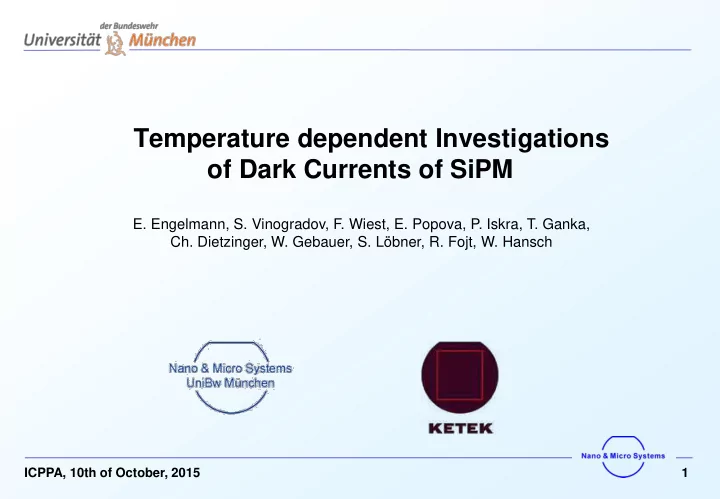

Temperature dependent Investigations of Dark Currents of SiPM E. Engelmann, S. Vinogradov, F. Wiest, E. Popova, P. Iskra, T. Ganka, Ch. Dietzinger, W. Gebauer, S. Löbner, R. Fojt, W. Hansch ICPPA, 10th of October, 2015 1
Motivation Goal of this work : reduction of dark count rate of Silicon Photomultipliers gain initial information on dark generation and extract contributions to dark current activation energies determined from T dependencies are expected to General approach : be a good indicator of physical mechanisms conventional methods of extraction of E act at fixed voltages/overvoltages may not be suitable effects dependent on voltage and overvoltage cannot be separated independent measurements of photo- and dark-response Proposed method : separation of overvoltage dependent responsivity and voltage dependent high-field effects find expression for field-independent generation component ICPPA, 10th of October, 2015 2
Setup KETEK 3x3 mm 2 in a TO8 • temperature dependent investigations were performed in a range from 20°C to -30°C • the measurements were executed on a KETEK 3x3mm 2 SiPM which was mounted on a Peltier element and evacuated in a TO8 module ICPPA, 10th of October, 2015 3
Conventional Method • conventional method as proposed in R.Pagano et al.; „Dark Current in Silicon Photomultiplier Pixels: Data and Model“; IEEE Transactions on Electron Devices; Vol.59 NO. 9; 2012 is not suitable here • E act can not be attributed to a certain mechanism ICPPA, 10th of October, 2015 4
Proposed Method • dark and illuminated data was taken • assumption of an equal responsivity R, for electrons originating from dark generation and photoelectrons • in general this approach is applicable for any Response ρ , e.g. I dark or DCR ICPPA, 10th of October, 2015 5
Determination of I not_gained ICPPA, 10th of October, 2015 6
Determination of I gained • in order to determine the multiplied component, the difference between the measured dark current and I not_gained is investigated as a function of the responsivity • I diff could be described with a parabolic function in good agreement in the range between R=0 to R=4x10 6 • I gained represents initial charge carriers generated or provided to the multiplication region ICPPA, 10th of October, 2015 7
2nd Approach-Reconstruction of Dark Current ICPPA, 10th of October, 2015 8
Results-Activation Energies • I gained shows two activation Energies E 1 act ≈ E g and E 2 act ≈ E g /2 • F high_field lowers the effective activation energy by Δ E act • Δ E act is close to expected value for Poole-Frenkel effect ICPPA, 10th of October, 2015 9
Summary Results so far the chosen model for dark current could describe the measured data to a sufficiently precise level field-enhanced effects could be separated from generation components the extracted activation energies indicate that dark currents at T>-5°C are diffusion dominated, whereas currents at T<-5°C are dominated by generation (KETEK devices) Further investigations confirmation of model for different type of devices identification of micro-cell regions as origin for diffusion currents change technological process in order to reduce DCR ICPPA, 10th of October, 2015 10
Thank you for the attention ICPPA, 10th of October, 2015 11
Additional Slides ICPPA, 10th of October, 2015 12
1st Approach • analysing I gen consisting of a multiplied and non-multiplied component I 0 • I gained is assumed to be a small fraction of I not_gained V 0 ICPPA, 10th of October, 2015 13
1st Approach-Reconstruction of Dark Current ICPPA, 10th of October, 2015 14
Results- SensL • a 3x3mm 2 C-Series device from SensL was investigated for comparison • only one slope could be observed in the Arrhenius plot • E act of (0.57 ± 0.02) eV is attributed to generation current • the contribution of diffusion current is expected to be suppressed for this device ICPPA, 10th of October, 2015 15
Reconstruction of Dark Current ICPPA, 10th of October, 2015 16
Photocurrent ICPPA, 10th of October, 2015 17
Results-E act at fixed Overvoltage • the extracted E act directly from I dark (T) and DCR (T) at a fixed overvoltage show slightly different values, but agree within the uncertainties • E act from „ raw “ data is an indicator for physical mechanisms • for a precise analysis, a more advanced analysis is necessary ICPPA, 10th of October, 2015 18
DCR in extended T range ICPPA, 10th of October, 2015 19
Confirmation of Model • E act extracted from DCR is a sum of field-independent I gained and field-dependent F high_field • DCR measured and DCR reconstr show comparable E act within the uncertainties • this result is an indicator of the parameter fit quality • the measured DCR has to be addtionally corrected for avalanche triggering probability ICPPA, 10th of October, 2015 20
Reconstruction of DCR • DCR reconstr overestimates DCR measured • internal generation rate of dark events is expected to be higher than DCR • the measured DCR has to be addtionally corrected for avalanche triggering probability ICPPA, 10th of October, 2015 21
Recommend
More recommend